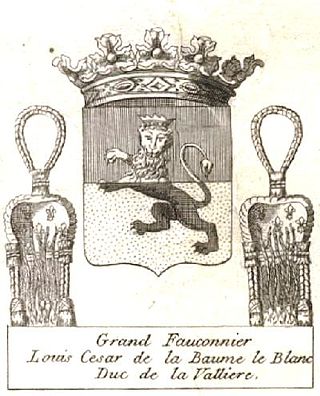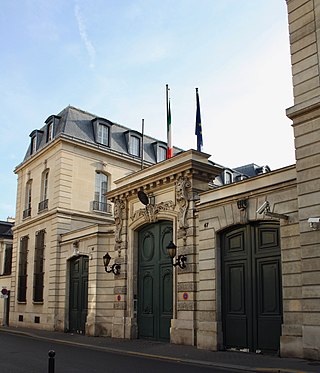Related Research Articles

The Prix de l'Arc de Triomphe is a Group 1 flat horse race in France open to thoroughbreds aged three years or older. It is run at Longchamp Racecourse in Paris, France, over a distance of 2,400 metres and scheduled to take place each year, usually on the first Sunday in October.

Chantilly is a commune in the Oise department in the Valley of the Nonette in the Hauts-de-France region of Northern France. Surrounded by Chantilly Forest, the town of 10,863 inhabitants (2017) falls within the metropolitan area of Paris. It lies 38.4 km north-northeast of the centre of Paris and together with six neighbouring communes forms an urban area of 37,254 inhabitants (2018).

Countess Marie Anatole Louise Élisabeth Greffulhe was a French socialite, known as a renowned beauty and queen of the salons of the Faubourg Saint-Germain in Paris.

The Grand Falconer of France was a position in the King's Household in France from the Middle Ages to the French Revolution.

Chantilly Racecourse is a Thoroughbred turf racecourse for flat racing in Chantilly, Oise, France, about 50 kilometres (31 mi) north of the centre of the city of Paris.
Alphi was a car manufacturer in France from 1929 to 1931. Only four cars were made.
Celtic Arms was a French Thoroughbred racehorse who competed successfully in both France and the United States. Bred by Georges Wegliszewski, he was out of the mare Amour Celtique, a daughter of American horse Northfields, winner of the Hawthorne and Louisiana Derbys. His sire was multiple French stakes winner, Comrade In Arms, a son of one of Britain's great runners, Brigadier Gerard.
Cacique is a retired Thoroughbred racehorse who competed in Europe and the United States. Bred and raced by Khalid Abdullah's Juddmonte Farms, Cacique is the son of the great international Champion sire, Danehill. He was out of the fantastic mare, Hasili whose damsire, Kahyasi, won the 1988 Epsom and Irish Derbys. Cacique is a full-brother to Breeders' Cup winners Banks Hill and Intercontinental and to Grade One winner Champs Elysees and Grade One-placed and Leading sire in France, Dansili.
Finasseur (1902–1909) was a French Thoroughbred racehorse who, at age three, won the two most prestigious races in France.
Henri Antoine Marie de Noailles, 11th Prince de Poix, 7th Duke of Mouchy was a French nobleman.
In The Wings (1986–2004) was a Thoroughbred racehorse who raced from a base in France. He was bred and raced by Sheikh Mohammed, and trained in France by André Fabre,
Scratch, also known as Scratch II was a French Thoroughbred racehorse and sire best known for winning the Prix du Jockey Club and the classic St Leger Stakes in 1950. Scratch won the Solario Stakes in England as a two-year-old and emerged as one of the best of a very strong generation of French-trained colts in the following year. He won the Prix de Guiche and Prix Greffulhe in the early part of the year and then defeated the year's outstanding three-year-old colt Tantieme in the Prix du Jockey Club. In the autumn of 1950 he won the St Leger by defeating Vieux Manoir, who had beaten him in the Grand Prix de Paris. He won the Prix Jean Prat as a four-year-old before being retired to stud where he had an unremarkable record as a sire of winners in Europe and South America.

The Hôtel de Boisgelin, a.k.a. Hôtel de La Rochefoucauld-Doudeauville, is a hôtel particulier in Paris, France. It houses the Italian embassy in France. It has been listed since 1926 as a monument historique by the French Ministry of Culture.
Saonois is a French Thoroughbred racehorse and sire. Unlike most leading French racehorses which are trained in and around Paris and owned by multi-millionaires, Saonois was trained in the French provinces, conditioned by a little-known trainer and owned by a local baker. The colt won three of his seven races on minor tracks as a two-year-old and won one of his two starts at Cagnes-sur-Mer in early 2012. When sent to compete at the major Parisian tracks he won the Prix La Force and finished fourth in the Prix Greffulhe before recording an upset win in the Prix du Jockey Club. Later that year he won the Prix Niel but ran poorly in the Prix de l'Arc de Triomphe and the Hong Kong Cup. He remained in training in 2013, but failed to recover his best form.
Clairvoyant was a French Thoroughbred racehorse and sire. He won five of his six races was probably the best three-year-old colt in Europe in 1937 when he won the Prix Matchem, Prix Hocquart, Prix Lupin, Prix du Jockey Club and Grand Prix de Paris. He was retired to stud, but disappeared from the record during the Second World War: his final fate is unknown.

Louis Alexandre de La Rochefoucauld, 6th Duke of La Rochefoucauld was a French nobleman and politician. He was a member of the House of La Rochefoucauld and a major lord under the Ancien Régime. He also played a political role in 1789 early on in the French Revolution before being executed in the September Massacres. He was a duke, initially with the title 'duc d'Enville' or 'duc d'Anville' and later with that of 6th duc de La Rochefoucauld. He was a cousin to François Alexandre Frédéric de La Rochefoucauld-Liancourt and Ambroise-Polycarpe de La Rochefoucauld-Doudeauville.
Behkabad is a French Thoroughbred racehorse and sire. As a two-year-old in 2009 he was undefeated in three races including the Group 3 Prix des Chênes. In the following spring he lost his unbeaten record in the Prix Omnium II but then took the Prix de Guiche. He rebounded from a disappointing effort in the Prix du Jockey Club to win the Grand Prix de Paris and then returned in autumn to win the Prix Niel. Later that year he finished fourth when favourite for the Prix de l'Arc de Triomphe and ran third in the Breeders' Cup Turf. After finishing second on his only race as a four-year-old he was retired from racing and exported to become a breeding stallion in Japan.
Philippe Anne Louis Marie Dieudonné Jean d'Albert, 11th Duke of Luynes was a French aristocrat who became the Duke of Luynes at the age of nineteen and held the title until his death in 1993.
François de Cossé, 13th Duke of Brissac, was a French aristocrat and landowner. He held the French noble title of Duke of Brissac from 1993 until his death in 2021.